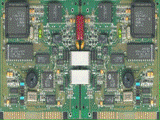Electrical & Computer Engineering, Department of
Date of this Version
2003
Abstract
Space Time Spreading systems are proposed as a method to enhance communications between the Base Station (BS) and Mobile Station (MS) by using multiple transmit antennas at the Base Station. This provides a form of transmit diversity when there are more than one transmitting antennas. Space Time Spreading systems have been shown to be efficient in their use of the limited number of orthogonal spreading sequences and to provide a diversity gain, which in the case of two transmitter antennas at the BS and one receiving antenna at the MS, is of order two. The paper looks at the effect of unsynchronized adjacent cell interference caused by scatterers causing the target MS to experience Multiple Access Interference (MAI) due to misaligned orthogonal codes from adjacent sectors in a sectorised cell (with 120 degree sectorisation). The study finds that adjacent MAI does adversely influence the Bit Error Rate (BER) of the target MS.


Comments
Published in the Proceedings of the 7th International Symposium on Digital Signal Processing and Communication Systems (DSPCS’03) and the Proceedings of the 2nd Workshop on the Internet, Telecommunications and Signal Processing (WITSP’03), Coolangatta, Australia (December 2003) (7 p.). Copyright 2003, IEEE. Used by permission.